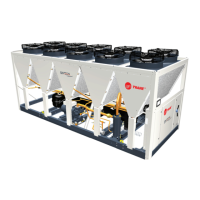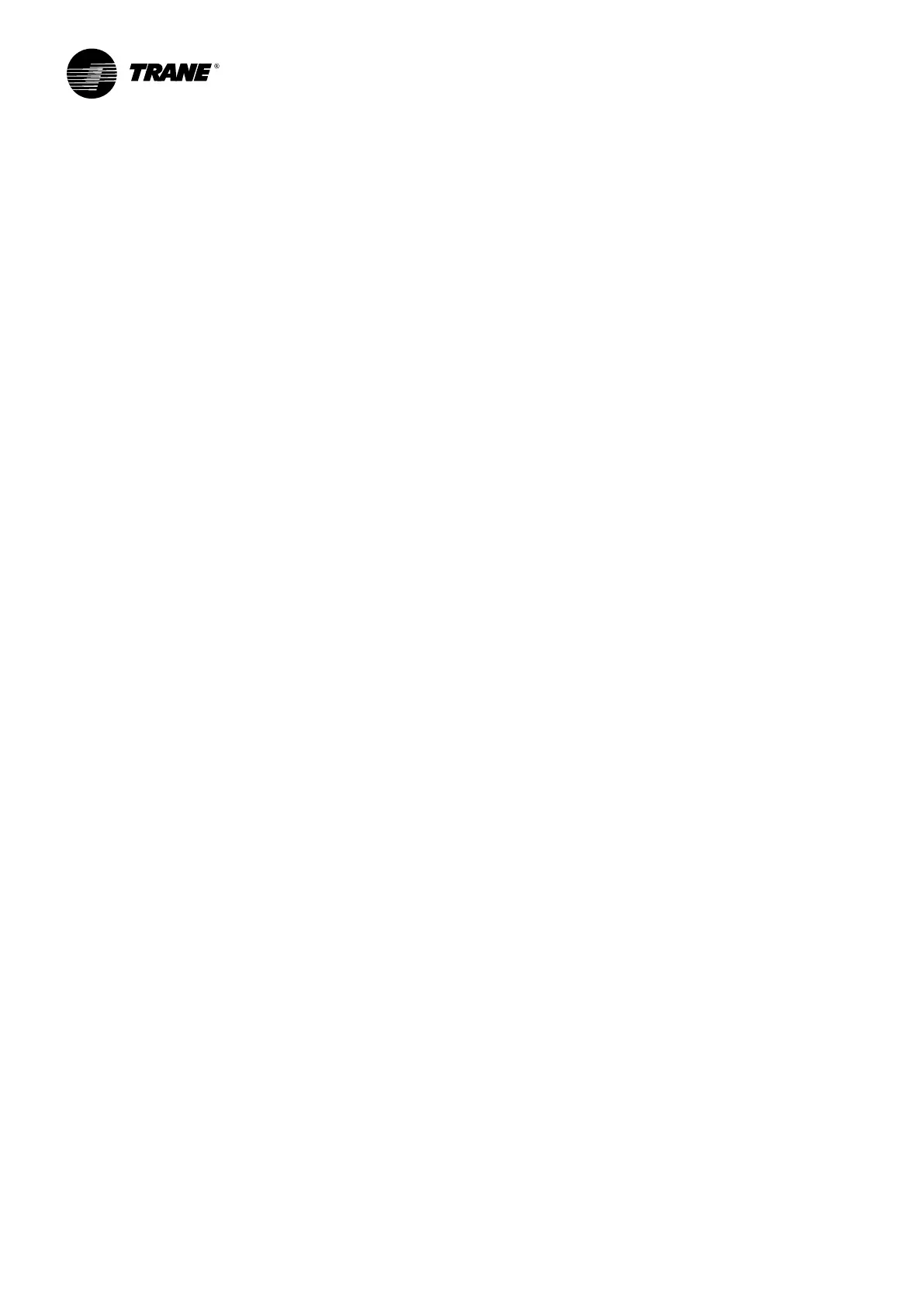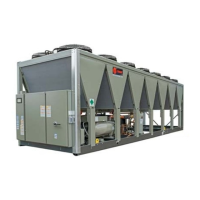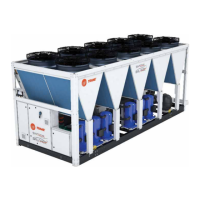RLC-SVX19G-GB
160
4 UNT-PRC002-GB
Technical Data
FWD 08 12 20 30 45
Power supply (V/Ph/Hz) 230/1/50
Capacities
Cooling capacity on water (1) (kW) 5,2 8,3 15 18,8 30,1
Heating capacity on water (2) (kW) 6,3 11,9 18,9 20,9 38,2
Fan motor (type) 2 x direct drive centrifugal
Fan power input (3) (kW) 0,23 0,46 0,65 1,04 1,51
Current amps (3) (A) 1,1 2,2 3,1 4,7 5,5
Start-up amps (A) 3,2 5,5 9,3 14,1 16,5
Air flow
minimum (m
3
/h) 490 980 1400 1800 2700
nominal (m
3
/h) 820 1650 2300 3000 4500
maximum (m
3
/h) 980 1970 2600 3600 5400
Main coil
Water entering/leaving connections (type) ISO R7 rotating female
(Dia) 3/4" 3/4" 1 1/2" 1 1/2" 1 1/2"
Electric heater (accessory for blower only)
Electric power supply (V/Ph/Hz) 230/1/50 230/1/50 or 400/3/50 400/3/50 400/3/50 400/3/50
Heating capacity (kW) 2/4 8 10 12 12
Hot water coil (accessory for blower only)
Heating capacity (4) (kW) 6,3 12 17,4 22,4 34,5
G2 filter (filter box accessory)
Quantity 2 2 2 2 2
Dimensions ( LxWxth) (mm) 386x221x8 486x271x8 586x321x8 586*421*8 586*621*8
G4 filter (filter box accessory)
Quantity - 2 2 2 2
Dimensions ( LxWxth) (mm) - 486x264x48 586x314x48 586*414*48 586*614*48
Condensate pump (accessory) (type) Centrifugal
Water flow - lift height (l/h - mm) 24 - 500
Not available for FWD30 and FWD45
Sound level (L/M/H speed)
Sound pressure level (5) (dB(A)) 36/40/43 38/41/44 46/50/53 47/52/57 47/52/58
Sound power level (5) (dB(A)) 46/50/53 48/51/54 56/60/63 57/62/67 57/62/68
Unit dimensions
Width x Depth (mm) 890 x 600 1090 x 710 1290 x 820 1290 x 970 1290 x 1090
Height (mm) 250 300 350 450 650
Shipped unit dimensions
Width x Depth (mm) 933 x 644 1133 x 754 1333 x 864 1333 x 1008 1333*1133
Height (mm) 260 310 360 460 660
Weight (kg) 32 46 61 76 118
Colour galvanised steel
Recommended fuse size
Unit alone (aM/gI) (A) 8/16 8/16 8/16 8/25 8/25
Unit with electric heater (gI) (A) 16 (2kW),25 (4kW) 40 (230V),3*16 (400V) 3*20 3*25 3*25
(1) Conditions: Water entering/leaving temperature: 7/12 °C, Air inlet temperature 27/19°C DB/WB - Nominal air flow
(2) Conditions: Water entering/leaving temperature: 50/45 °C, Air inlet temperature 20°C DB - Nominal air flow
(3) At high speed with nominal air flow.
(4) Water entering/leaving temperature 90/70 °C, air inlet temperature 20 °C DB, Nominal air flow.
(5) A rectangular glass wool duct 1m50 long is placed on the blower.The measurement is taken in the room containing the blower unit.
Heat exchanger operating limits:
FWD:
*water temperature: max 100° C
*absolute service pressure: min 1 bar/max 11 bars
Accessories - Hot water coil:
*water temperature: min. +2° C/max. 100° C
*absolute service pressure: min 1 bar/max 11 bars
Pre-Start Checkout
Installation Checklist
Complete this checklist as the unit is installed, and verify
that all recommended procedures are accomplished
before the unit is started. This checklist does not replace
the detailed instructions given in the “Installation
Mechanical” and “Installation Electrical” sections of
this manual. Read both sections completely, to become
familiar with the installation procedures, prior beginning
the work.
General
When installation is complete, before starting the unit,
the following prestart procedures must be reviewed and
verified:
1. Inspect all wiring connections in the compressor
power circuits (disconnects, terminal block,
contactors, compressor junction box terminals and
so forth) to ensure they are clean and tight.
2. Open all refrigerant valves in the discharge, liquid,
and oil return lines.
3. Check the power-supply voltage to the unit at the
main-power fused-disconnect switch. Voltage must
be within the voltage use range and also stamped
on the unit nameplate. Voltage fluctuation must not
exceed 10%.Voltage imbalance must not exceed 2%
4. Check the unit power phasing L1-L2-L3 in the starter
to ensure that it has been installed in a “A-B-C” phase
sequence.
5. Fill the evaporator chilled-water circuit. Vent the
system while it is being filled. Open the vents on
the top of the evaporator water box while filling and
close when filling is completed.
6. Close the fused-disconnect switch(es) that supplies
power to the chilled-water pump starter.
7. Start the chilled-water pump to begin circulation of
the water. Inspect all piping for leakage and make
any necessary repairs.
8. With water circulating through the system, adjust
the water flow and check the water pressure drop
through the evaporator.
9. Adjust the chilled-water flow switch for proper
operation.
10. Reapply power to complete the procedures
11. Prove all Interlock and Interconnecting Wiring
Interlock and External as described in the Electrical
Installation section.
12. Check and set, as required, all UC800 TD7 menu
items.
13. Stop the chilled-water pump.
14. Energize the compressor and oil separator heaters
24 hours, prior to unit start up.
Unit Voltage Power Supply
Unit voltage must meet the criteria given in the
installation Electrical Section. Measure each lead of
the supply voltage at the main power fused-disconnect
switch for the unit. If the measured voltage on any lead
is not within the specified range, notify the supplier of
the power and correct the situation before operating the
unit.
Unit Voltage Imbalance
Excessive voltage imbalance between the phases of a
three-phase system can cause motors to overheat and
eventually fail. The maximum allowable unbalance is
2%. Voltage imbalance is determined using the following
calculations:
% Imbalance = [(Vx – Vave) x 100/Vave]
Vave = (V1 + V2 + V3)/3
Vx = phase with greatest difference from Vave (without
regard to the sign)
Unit Voltage Phasing
It is important that proper rotation of the compressors
be established before the unit is started. Proper motor
rotation requires confirmation of the electrical phase
sequence of the power supply. The motor is internally
connected for clockwise rotation with the incoming
power supply phases A-B-C.
When rotation is clockwise, the phase sequence is
usually called “ABC”, when counterclockwise “CBA”
This direction may be reversed by interchanging any two
of the line wires.
1. Stop the unit from TD7/UC800.
2. Open the electrical disconnect or circuit protection
switch that provides line power to the line power
terminal block(s) in the starter panel (or to the unit
mounted disconnect).
3. Connect the phase-sequence indicator leads to the
line power terminal block (L1-L2-L3).
4. Turn power on by closing the unit supply-power
fused-disconnect switch.
5. Read the phase sequence on the indicator. The ABC
LED of the phase indicator will glow.

